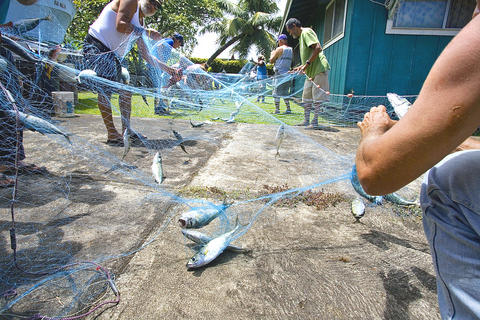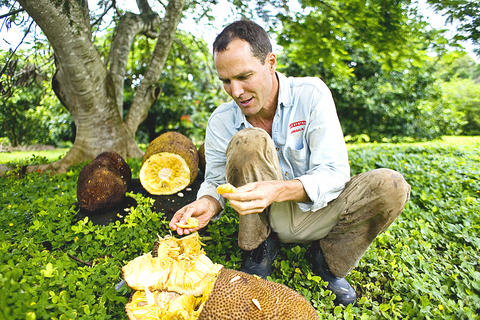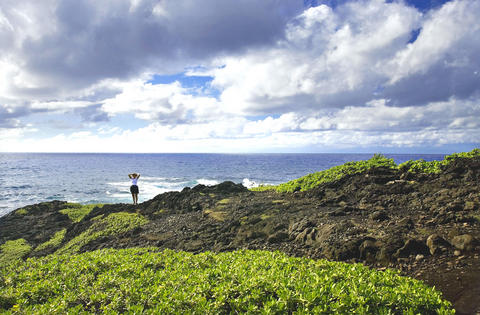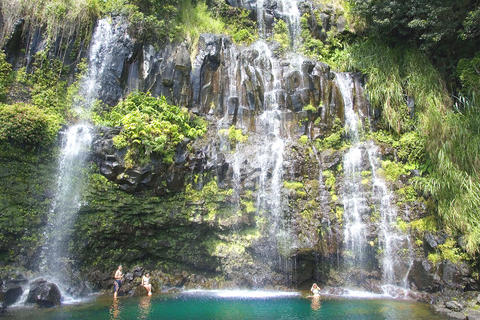The ocean crashed hypnotically as the Venus of Hana yoga gently gave her commands. "Let the sun rise over the crater," she said, her arm arching into an ethereal halo over her head. She read a poem by Mary Oliver, sang awhile and instructed us to extend our buttocks toward Hana. We closed our eyes, dimly aware of the wind rustling through banana leaves.
Then our yogi, Erin Lindbergh, summed up how it feels to spend a slow Sunday morning on the edge of the earth in a tropical nirvana where all of nature seems to be on Viagra. "There is a bowl of flowers in your heart," she said.
Nearly 40 years ago, her grandfather - Charles Lindbergh - became one of a multitude of seekers to be smitten by Hana, on the east coast of Maui. He is buried in a swamp mahogany coffin at the Hoomau Congregational Church in Kipahulu, not far from his granddaughter's yoga studio, his now-mossy grave rimmed by beach rock. Like the manic hordes who form a human chain in rented Mustangs and PT Cruisers on the Hana Highway, fleeing chain-hotel sterility on the "other side" of Maui, the legendary pilgrim of the skies was restlessly searching for serenity, a sacred sense of apartness.

PHOTO: NY TIMES NEWS SERVICE
To his granddaughter, who recently moved from Montana, and bears an uncanny resemblance to her grandmother Anne Lindbergh, this remote fleck of paradise some 84km, 617 hairpin curves and 56 one-lane bridges away from the nearest city possesses mana, "a life energy," an unseen spiritual force.
"Hana appeals to the calmer side of one's being," Sunni Kaikala Hueu, a Hana native, has written. "Some say that Hana is almost medicinal in nature - a quiet vibration that is felt."
The vibes can be profound, all right. Where else but in Hana - its fabled highway the approximate width of a suburban driveway - is it possible to encounter traffic jams beside hidden waterfalls as tourists pose for "Coming of Age in Samoa" shots with cellphones? Where perma-culturally inclined off-the gridders live in New Age treehouses and make bike-powered smoothies, while across the street in a community kitchen, a tiny 80-something kapuna in pink pedal-pushers peels boiled taro the old-fashioned way: with an opihi, or limpet, shell.

PHOTO: NY TIMES NEWS SERVICE
In these jungled thickets, hot enough to make lipstick melt, the escapist Garden of Eden fantasies of to-do haole, as rich Caucasians are called, converge and occasionally collide with native truths. The seductive mix of aloha and pristine beauty - the happy product of Hana's geographic isolation - has long drawn moneyed sophisticates, from Samuel Pryor, a Pan Am vice president, who shares his eternal rest with his crony Lindbergh as well as his pet gibbons, whom he dressed as children, to more recent emigres like Woody Harrelson, Kris Kristofferson and George Harrison. Most recently there is Oprah the Divine, who has bought some 40 hectares of Hana coastline, including a venerated cinder cone said to contain the bones of the volcano goddess Pele.
For some 750,000 visitors a year, Hana is a way station en route to the Seven Sacred Pools - a series of pools and waterfalls of Tarzan-like perfection that, thanks to sheer numbers, have sadly become the Jersey Shore of Hana. The day-trippers may avoid Hana Highway robbery (US$16-a-kilogram coffee), but on an island more commonly associated with strip malls, golf and swimming pools with fake shipwrecks for the kiddies, they may also miss Hana's essence: a fragile oasis of Hawaiian culture not unlike trees that miraculously survive the onslaught of burning lava.
Down the road from the Hotel Hana-Maui, a US$475-plus-a-night watering hole stretching languorously to the sea, a man named Blondie, who was anything but, was sitting in a thatched hut scanning the ocean for nervous ripples. He is a kilo ia, an ace fish spotter. The hut is the akule hale, the fisherman's meeting house, a hangout with a pebbled dirt floor and a calendar mounted with a clothespin. It is a lair for men who have gone holo holo (a waggish term for fishing).

PHOTO: NY TIMES NEWS SERVICE
They were awaiting the arrival of scad mackerel, signaling the start of the modern hukilau, an enterprise involving cellphone communiques, Polaroid sunglasses and power and paddle boats scaring fish into nets. When the akule come in, all of Hana partakes.
The fish are but an excuse to "talk story," fortified this day by numerous pre-breakfast beers and fish sizzling in a huge skillet. Burt Freeland, the local undertaker, spoke of a phone call he had just received from the police about an address: "They asked the auntie for her house number and she said, 'I don't know.' She never knew she had one."
Not knowing one's own address struck me as very Hana. Stay awhile and the local intelligence comes fast and furious: The ocean is "our icebox." The taro plant is a divine ancestor. Never turn your back on the ocean. Flash floods can kill even on sunny days.

PHOTO: NY TIMES NEWS SERVICE
"A jeep full of haole washed down the mountain on a solid wall of water and floated 5km downstream," Freeland said. "If clouds are on the mountain, don't stay in the ravine."
Those who live there know that what Hana giveth, Hana can take away.
"Hana is not for the faint of heart," Arabella Ark, a voluble ex-Californian ceramicist and my bed-and-breakfast proprietor, would explain later. "It either absorbs you or spits you out."
I had pulled into Ark's driveway on a late May evening, dodging myna birds, the pigeons of the Hana Highway. All around was ripeness. The house, once the home of the doctor who treated Lindbergh, effervesced with Tahitian gardenias and ti leaves with magenta berries resembling 1940s costume jewelry. It felt as if I were entering a corsage.
My first day, I met an heiress who owns a waterfall and lives in a Samoan-style oceanfront villa. We zoomed around in a Kawasaki off-road vehicle, braking by her orchid greenhouse. In her living room, chickens improbably skittered around Sam Maloof furniture (one laid an egg).
She spoke eloquently of the coast's bloody history, of centuries-old battles between Big Island and Maui chiefs for control of its natural riches. "Hana is a vortex," she explained, before jetting off to New York for an art opening.
Indeed, history casts a long shadow in Hana. It was there, according to legend, that the demi-god Maui fished up the Hawaiian islands from the ocean with a magic fishhook, lifting the heavens high above the earth so that humans could walk upright.
At a school assembly held under a shower tree, first graders with yellow hibiscus behind their ears sang of the aina, the land, and a fifth-grader with silken hair danced the hula in a white dress. Native families like Fawn Kukanakala-Helekaahi-Burns', one of the parents there, still make a pilgrimage on foot to Haleakala crater when a baby is born to bury the piko, or umbilical cord, beneath a life-sustaining rock or tree. Land is kin: the native language does not have a word for private property, but dozens for rain.
It was around Day 1.5 that I began to develop the living-in-Hana fantasy. At dawn, I opened the louvered glass shutters of Ark's guest cottage, her Carmen Miranda foliage redolent from evening rain. From the lawn, the Big Island rose mirage-like in the distance, the ocean the color of a pearl.
I jogged along the empty Hana Highway, dodging fragrant, fermenting mangoes that would thud Chicken Little-like in my path. There were ancient rock walls, mossy one-lane bridges with construction dates chiseled in old calligraphy. One day, I saw a street sweeper clean up what passes for garbage - breadfruit leaves.
Erin Lindbergh has come to understand her grandfather's connection to this place, though she was only 12 when he died in 1974.
"People here are so present," she said yogically. "There is no artifice. So they allow you to be who you are."
She shared this wisdom as we bushwhacked through cane grass in the jungle, the serrated edges like razors on my sunburned legs. We were climbing to a spring-fed pool and waterfall high in the mountains, accompanied by her dog and my husband, Roger, who had flown in briefly for our 20th wedding anniversary. The air was dense with humidity; soon, it began to rain. She was a sweatless, smudgeless still life in white linen. Thorns only added to her luster.
At last the enchanted pool loomed, a vision by Henri Rousseau. She disrobed, plunging in taut down-dog near-nothingness into the water, more perfect even than linen. Roger stood transfixed. I began channeling Nora Ephron.
People come to Hana to reinvent themselves. Anne Lindbergh understood this well: she christened her home Argonauta, a reference to a mother who leaves her shell to start a new life.
Ark moved to Hawaii 35 years ago with her first husband after living in Paris. Her neighbor on Oahu was Marvin Nogelmeier, "a hippie jeweler from Minnesota." He is now Puakea Nogelmeier, a celebrated authority on Hawaiian language and culture.

On April 26, The Lancet published a letter from two doctors at Taichung-based China Medical University Hospital (CMUH) warning that “Taiwan’s Health Care System is on the Brink of Collapse.” The authors said that “Years of policy inaction and mismanagement of resources have led to the National Health Insurance system operating under unsustainable conditions.” The pushback was immediate. Errors in the paper were quickly identified and publicized, to discredit the authors (the hospital apologized). CNA reported that CMUH said the letter described Taiwan in 2021 as having 62 nurses per 10,000 people, when the correct number was 78 nurses per 10,000

As we live longer, our risk of cognitive impairment is increasing. How can we delay the onset of symptoms? Do we have to give up every indulgence or can small changes make a difference? We asked neurologists for tips on how to keep our brains healthy for life. TAKE CARE OF YOUR HEALTH “All of the sensible things that apply to bodily health apply to brain health,” says Suzanne O’Sullivan, a consultant in neurology at the National Hospital for Neurology and Neurosurgery in London, and the author of The Age of Diagnosis. “When you’re 20, you can get away with absolute

May 5 to May 11 What started out as friction between Taiwanese students at Taichung First High School and a Japanese head cook escalated dramatically over the first two weeks of May 1927. It began on April 30 when the cook’s wife knew that lotus starch used in that night’s dinner had rat feces in it, but failed to inform staff until the meal was already prepared. The students believed that her silence was intentional, and filed a complaint. The school’s Japanese administrators sided with the cook’s family, dismissing the students as troublemakers and clamping down on their freedoms — with

As Donald Trump’s executive order in March led to the shuttering of Voice of America (VOA) — the global broadcaster whose roots date back to the fight against Nazi propaganda — he quickly attracted support from figures not used to aligning themselves with any US administration. Trump had ordered the US Agency for Global Media, the federal agency that funds VOA and other groups promoting independent journalism overseas, to be “eliminated to the maximum extent consistent with applicable law.” The decision suddenly halted programming in 49 languages to more than 425 million people. In Moscow, Margarita Simonyan, the hardline editor-in-chief of the